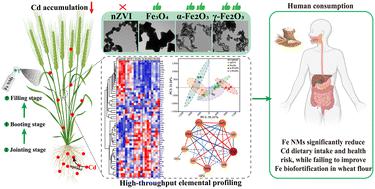当前位置:
X-MOL 学术
›
Environ. Sci.: Nano
›
论文详情
Our official English website, www.x-mol.net, welcomes your feedback! (Note: you will need to create a separate account there.)
Foliar application of iron-based nanofertilizers to wheat grown in a Cd-contaminated field: implications for food safety and biofortification
Environmental Science: Nano ( IF 5.8 ) Pub Date : 2024-05-02 , DOI: 10.1039/d3en00958k Jiapan Lian 1 , Liping Cheng 1 , Xiwei Huang 1 , Xin Wang 1 , Yi Wang 2 , Chaoyi Deng 2 , Xiaoping Xin 3 , Tong Zou 1 , Yonglong Chen 1 , Hongyu Yu 1 , Weitao Liu 4 , Jianqing Pan 5 , Zhenli He 3 , Xiaoe Yang 1 , Jason C. White 2
Environmental Science: Nano ( IF 5.8 ) Pub Date : 2024-05-02 , DOI: 10.1039/d3en00958k Jiapan Lian 1 , Liping Cheng 1 , Xiwei Huang 1 , Xin Wang 1 , Yi Wang 2 , Chaoyi Deng 2 , Xiaoping Xin 3 , Tong Zou 1 , Yonglong Chen 1 , Hongyu Yu 1 , Weitao Liu 4 , Jianqing Pan 5 , Zhenli He 3 , Xiaoe Yang 1 , Jason C. White 2
Affiliation

|
Nanotechnology applications in agriculture have received considerable attention with the aim of improving crop production, nutritional quality and food safety. The comparative effects of four different iron-based nanomaterials (Fe NMs, 50 mg Fe L−1) on wheat were investigated following foliar application in a Cd-contaminated field trial. The results showed that α-Fe2O3 NMs, γ-Fe2O3 NMs and Fe3O4 NMs significantly reduced the Cd concentration in wheat grain (by 60.9%, 44.7% and 50.1%, respectively) below the established Cd safety threshold (0.1 mg kg−1), but only γ-Fe2O3 NMs could simultaneously improve grain yield (by 8.6%) and the PA/Fe molar ratio in white flour (17.9%) compared to the control. Furthermore, α-Fe2O3, γ-Fe2O3 and Fe3O4 NMs significantly lowered the dietary Cd exposure and health risk by 44.2–57.9% by reducing Cd concentrations and bioaccessibility in wheat flour. The ionomic analysis demonstrated that with the exception of nZVI, elemental homeostasis was more sensitive to Fe NMs in the wheat leaf and glume, and a significant negative correlation between Cd and P, as well as Mo and Ca were observed. Overall, these findings highlight the significant potential of γ-Fe2O3 NMs as an effective foliar agent for safe wheat production and biofortification in nano-enabled agriculture.
中文翻译:

叶面施用铁基纳米肥料对镉污染田地中种植的小麦:对食品安全和生物强化的影响
纳米技术在农业中的应用受到了广泛关注,旨在提高作物产量、营养质量和食品安全。在镉污染田间试验中叶面喷施后,研究了四种不同铁基纳米材料(Fe NMs,50 mg Fe L -1 )对小麦的比较影响。结果表明,α-Fe 2 O 3 NMs、γ-Fe 2 O 3 NMs和Fe 3 O 4 NMs显着降低了小麦籽粒中的Cd浓度(分别降低了60.9%、44.7%和50.1%),低于设定的Cd浓度。安全阈值(0.1 mg kg -1),但与对照相比,只有γ-Fe 2 O 3 NMs能够同时提高籽粒产量(提高8.6%)和白面粉中的PA/Fe摩尔比(17.9%)。此外,α-Fe 2 O 3、γ-Fe 2 O 3和Fe 3 O 4 NMs通过降低小麦粉中的镉浓度和生物可及性,显着降低了膳食镉暴露和健康风险44.2-57.9%。离子组学分析表明,除nZVI外,元素稳态对小麦叶片和颖片中的Fe NMs更为敏感,并且观察到Cd和P、Mo和Ca之间存在显着的负相关。总体而言,这些发现凸显了 γ-Fe 2 O 3 NM 作为纳米农业中安全小麦生产和生物强化的有效叶面剂的巨大潜力。
更新日期:2024-05-02
中文翻译:

叶面施用铁基纳米肥料对镉污染田地中种植的小麦:对食品安全和生物强化的影响
纳米技术在农业中的应用受到了广泛关注,旨在提高作物产量、营养质量和食品安全。在镉污染田间试验中叶面喷施后,研究了四种不同铁基纳米材料(Fe NMs,50 mg Fe L -1 )对小麦的比较影响。结果表明,α-Fe 2 O 3 NMs、γ-Fe 2 O 3 NMs和Fe 3 O 4 NMs显着降低了小麦籽粒中的Cd浓度(分别降低了60.9%、44.7%和50.1%),低于设定的Cd浓度。安全阈值(0.1 mg kg -1),但与对照相比,只有γ-Fe 2 O 3 NMs能够同时提高籽粒产量(提高8.6%)和白面粉中的PA/Fe摩尔比(17.9%)。此外,α-Fe 2 O 3、γ-Fe 2 O 3和Fe 3 O 4 NMs通过降低小麦粉中的镉浓度和生物可及性,显着降低了膳食镉暴露和健康风险44.2-57.9%。离子组学分析表明,除nZVI外,元素稳态对小麦叶片和颖片中的Fe NMs更为敏感,并且观察到Cd和P、Mo和Ca之间存在显着的负相关。总体而言,这些发现凸显了 γ-Fe 2 O 3 NM 作为纳米农业中安全小麦生产和生物强化的有效叶面剂的巨大潜力。
















































 京公网安备 11010802027423号
京公网安备 11010802027423号